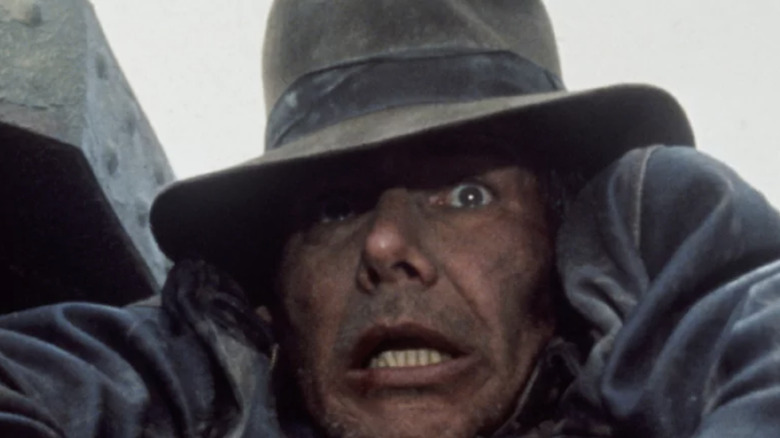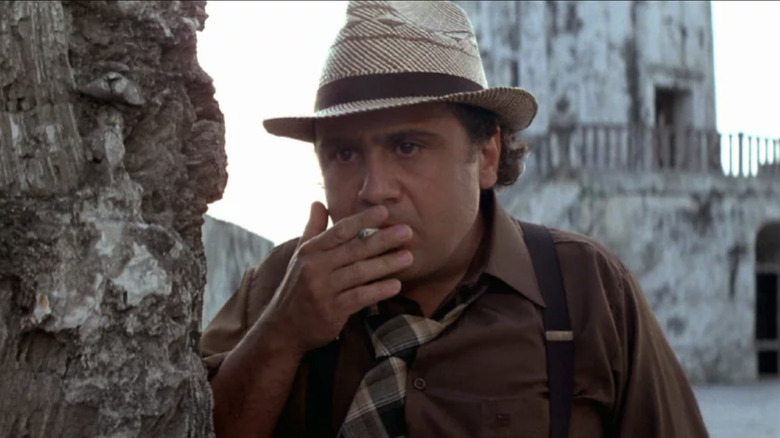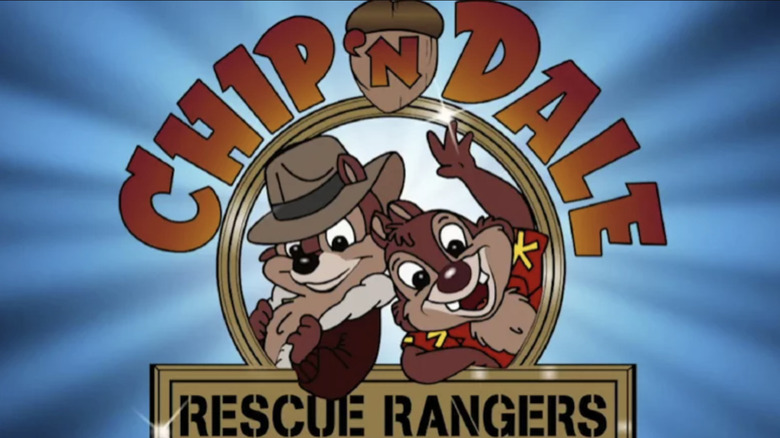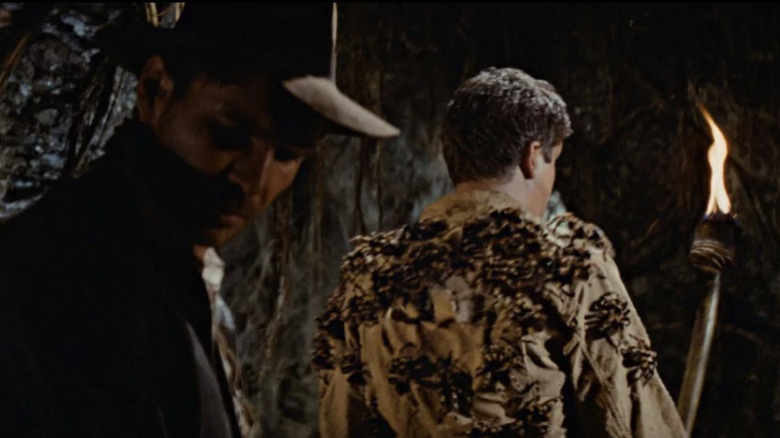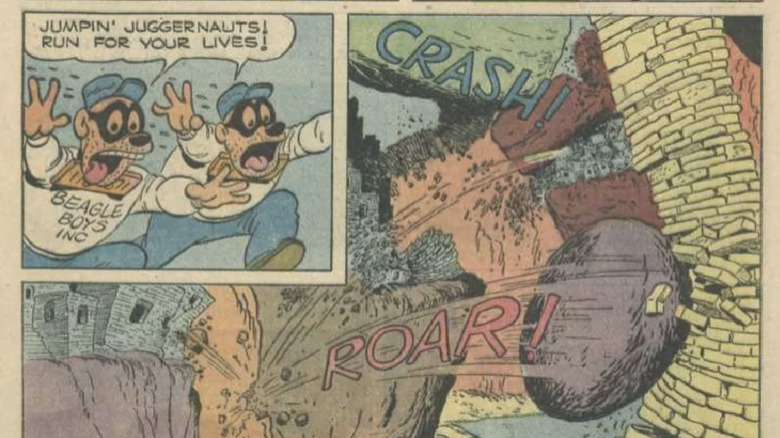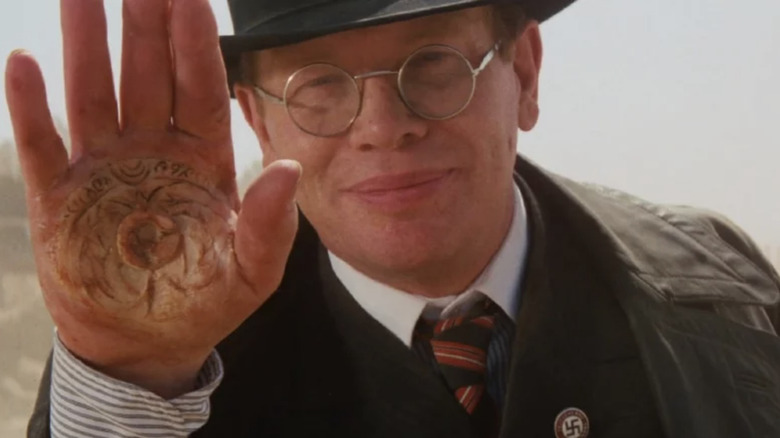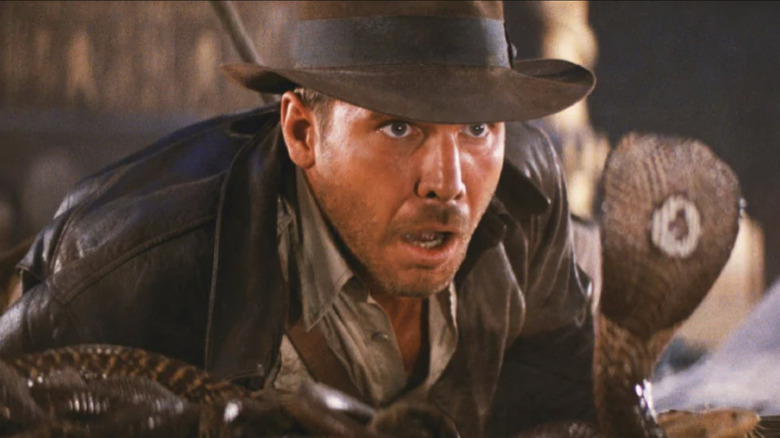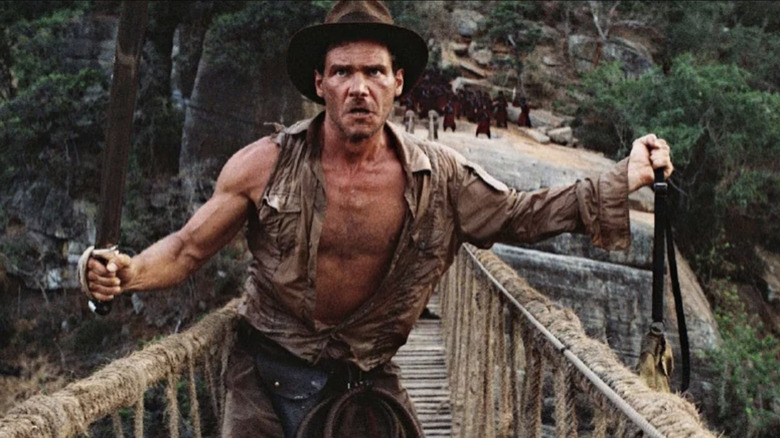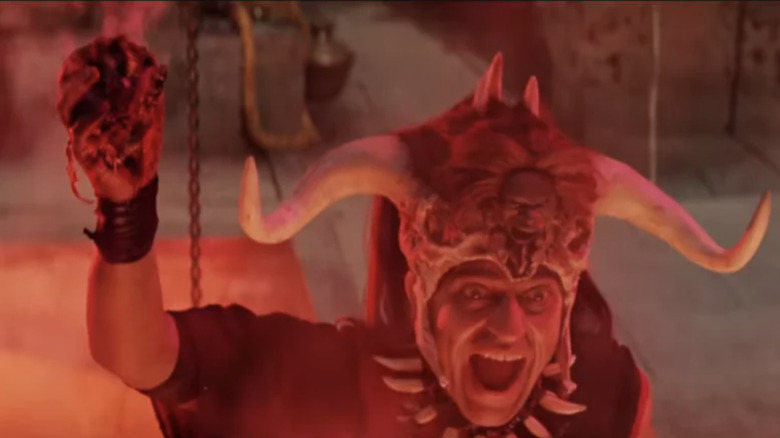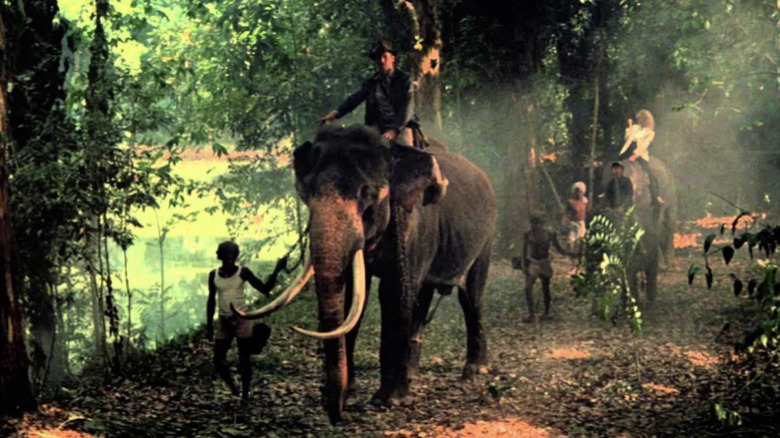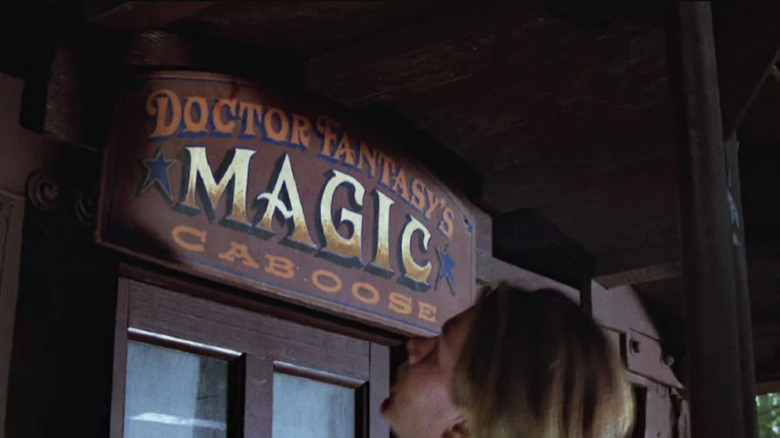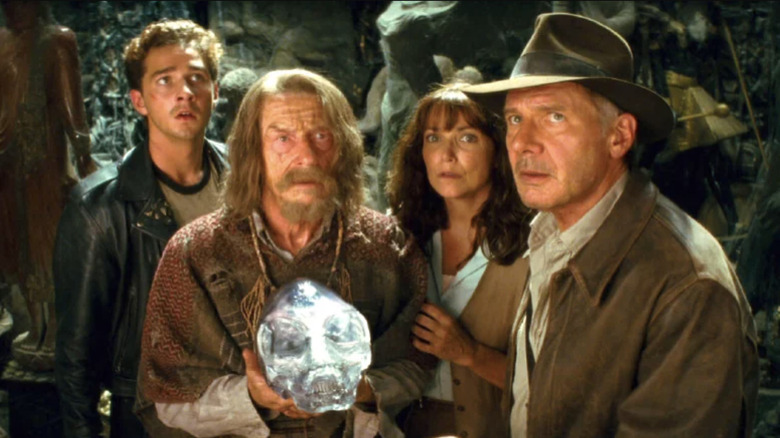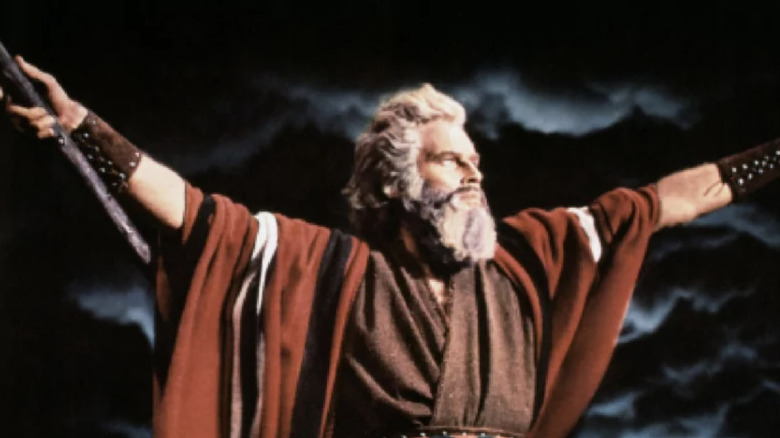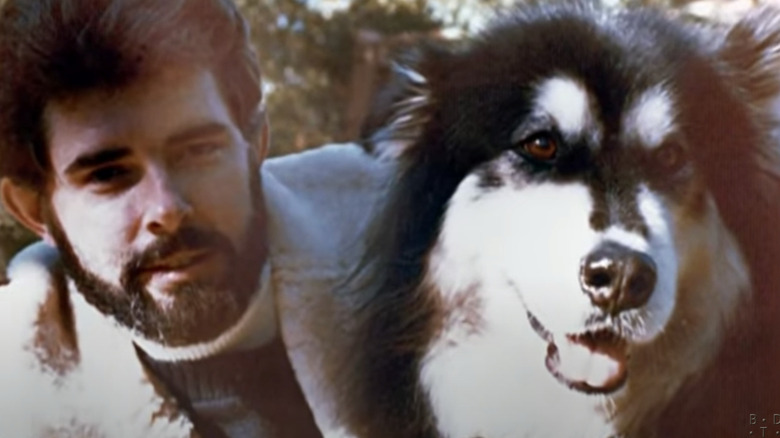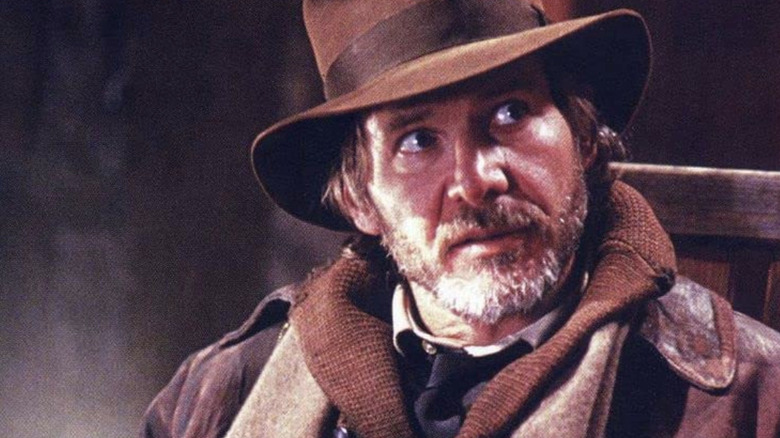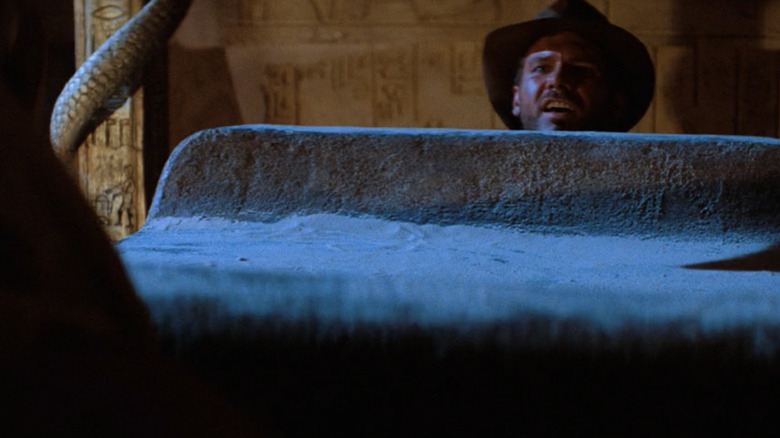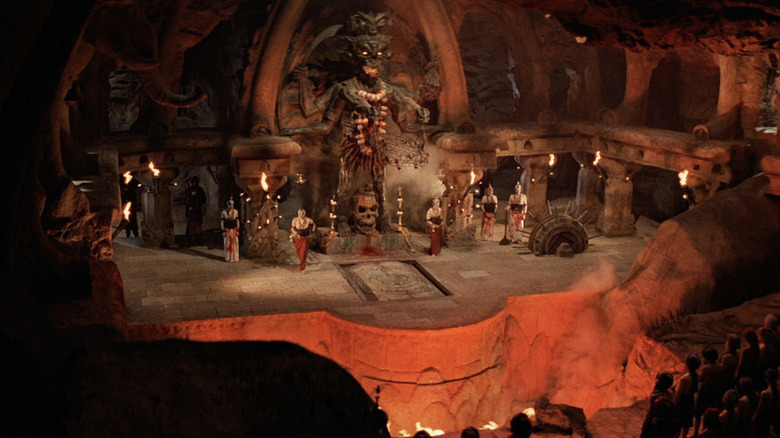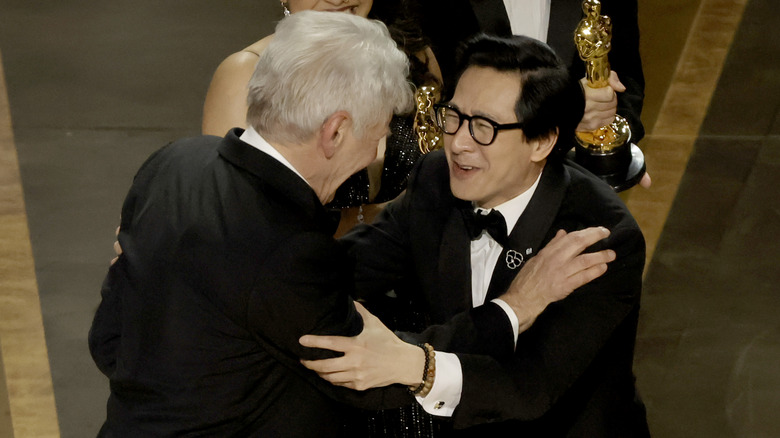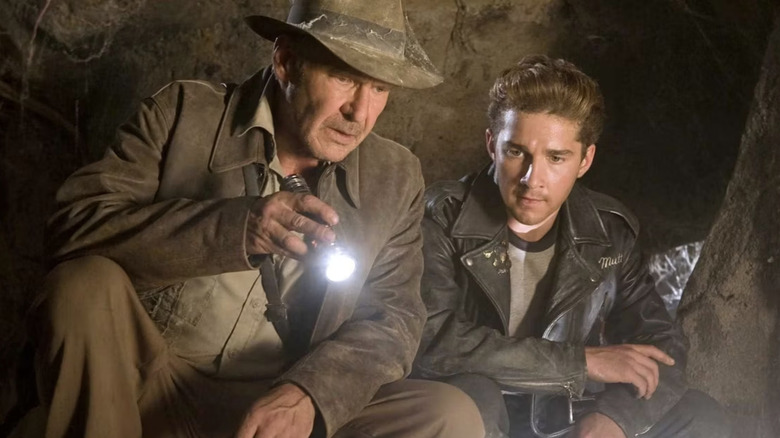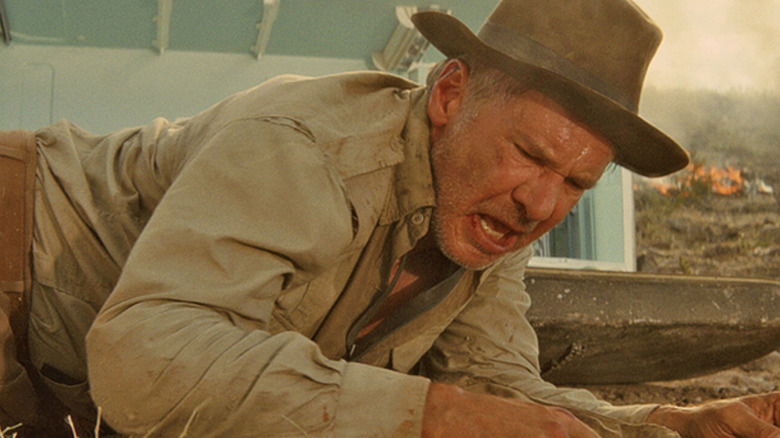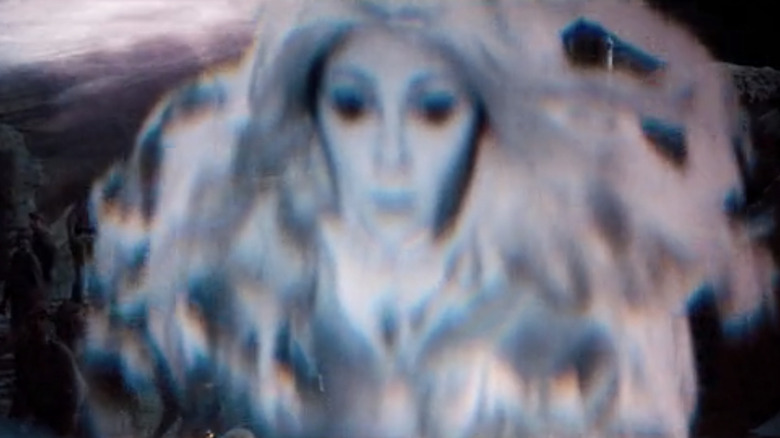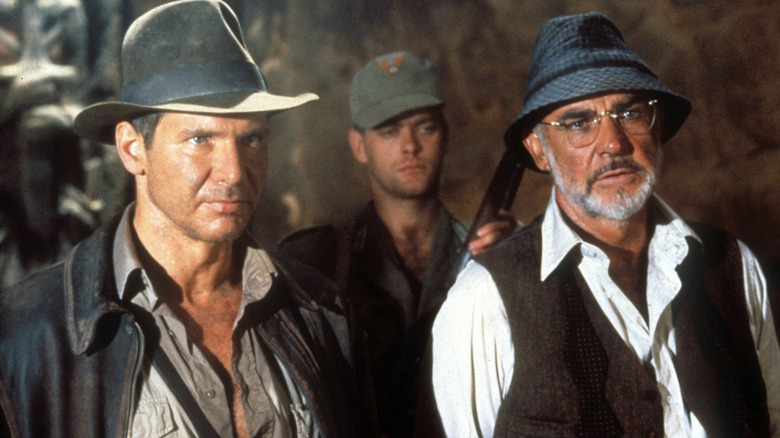The Untold Truth Of Indiana Jones
There are not a lot of movie characters like Indiana Jones. You can only find a handful of other action heroes who attract the kind of anticipation that surrounds the news of a new Indy movie, let alone one forty years after the first.
Indiana Jones began with an odd, deeply personal idea that took a long time for a studio to get behind — what if George Lucas and Steven Spielberg could make a version of the low-budget action serials of their youth that was actually as good as they remembered them being? Lucas had proven that formula could work with "Star Wars," and with "Raiders of Lost Ark," he applied it to the more earthbound adventures of his treasure-hunting heroes. In the process, he and Spielberg created a whole new genre of retro globetrotting action.
If most action heroes are either literally or figuratively superhuman, Harrison Ford's iconic performances gave us someone all too human. He can knock out a bad guy and steal his uniform, but it doesn't quite fit. He can survive a night in a tomb crawling with thousands of snakes, but it'll still scare him half to death. Indy's got enough humanity to keep us interested.
Indiana Jones' fictional adventures have taken him to the most startling places around the world. Here is the untold truth of Indiana Jones.
The cast of Indiana Jones could have been very different
It's hard to imagine anyone but Harrison Ford portraying Indiana Jones with his world-weary smirk, but like every role, the character could have gone to a number of different stars. GamesRadar reported that casting director Mike Fenton's pick was Jeff Bridges, who'd starred in "The Last Picture Show" and would go on to find his most iconic role in "The Big Lebowski."
But Indy's casting wasn't the only one in question, the supporting cast went through some changes too. For Indiana Jones' Egyptian buddy Sallah, Spielberg originally wanted Danny DeVito, but they couldn't come to terms on salary. But never fear, DeVito got his chance to play a similar role later, playing the Sallah-like Ralph to Michael Douglas' Indiana Jones-wannabe Jack T. Colt in "Romancing the Stone."
Catching John Rhys-Davies in the "Shogun" miniseries on TV inspired Spielberg to get him on the phone. Rhys-Davies was skeptical when he saw the script and later told Empire that he asked Spielberg, "Well, look, it says here that Sallah is a 5' 2" skinny Egyptian Bedouin. Are you proposing surgery?" Thankfully, Spielberg was happy to take Rhys-Davies as he was, and thus cast one of Indy's most important allies in the never-ending battle to uncover and preserve history.
Tom Selleck's casting inspired the most inside joke in cartoon history
The most famous might-have-been in the "Raiders of the Lost Ark" cast was Tom Selleck. Then a young unknown, he was Spielberg and Lucas's first choice for the part and even got as far as a screen test in a custom-fitted version of Indy's iconic fedora and bomber jacket. But NBC's "Magnum, P.I." wouldn't let Selleck out of his contract, so the "Raiders" crew had to find a new, available Indy.
It's the kind of story that circulates frequently through fan and industry circles, but it's certainly not the kind of thing you'd expect the average kid to know. So that makes it downright surreal that this bit of Hollywood Obscura became the basis for a popular cartoon series, but that's exactly what happened.
In 1989, "Chip 'N Dale Rescue Rangers" reinvented Donald Duck's least favorite pests as action heroes, with costumes to match. Chip wears the classic Indy getup (complete with a fedora), and Dale wears a Hawaiian shirt that looks an awful lot like the one Selleck made famous in "Magnum, P.I." Talk about an inside joke. The obscurity of the reference doesn't seem to have hurt the show though — "Rescue Rangers" ran three seasons, and Chip and Dale returned to Disney+ in 2022 with a new movie.
The wranglers trained spiders with the power of sexual tension
The "Indiana Jones" series sets its tone from the very beginning of "Raiders of the Lost Ark," with a classic, endlessly imitated mini-adventure of Indy raiding a booby-trapped South American temple to recover a solid gold idol. Many of the series' trademarks are already in place here, including its love of swarming creepy-crawlies. It isn't long before Indy and his guide, played by a young Alfred Molina, get swarmed by tarantulas, and then it gets interesting.
As any contemporary viewer can tell you after seeing so many sophisticated special effects, there isn't a single one here — those spiders are the real deal, which makes Ford and Molina all the braver. All kinds of movies have kept animal trainers on staff, and whole features have been built around the tricks that dogs and monkeys can pull off. But how exactly do you train a spider?
In the documentary "The Making of Raiders of the Lost Ark," Molina explains how. At first, the tarantulas just parked on top of him without doing anything, but that didn't last long. "I hear Steven saying, 'Why aren't they moving? They look fake!' And the spider wrangler says, 'Well, they're all male, you see. We have to put a female in there, and then they'll fight.' And he gets a female ... and suddenly, it's like all hell breaks loose!"
Raiders of the Lost Ark found its most famous scene in a Disney comic book
The scene where Indy escapes a giant rolling boulder in a South American temple has been copied and parodied more than almost any other — so much that even if you haven't seen the original version, you probably still have a pretty good idea what it's like. But believe it or not, even the original isn't totally original.
Carl Barks became a cult hero with his comics for Disney throughout the '40s and '50s, when he expanded the world of the Donald Duck cartoons. Admittedly, it can be hard not to think of Indiana Jones when reading through most of his stories, which feature countless adventures to recover ancient treasures from every corner of the earth.
But there's one in particular that should seem eerily familiar: In the Uncle Scrooge comic "The Seven Cities of Gold" (published in 1954), Donald and Scrooge discover an ancient city and narrowly escape when their rival treasure hunters the Beagle Boys attempt to remove a booby-trapped emerald idol, disturbing a boulder that destroys the whole place.
The connection is obvious, and internet sleuth Brian Cronin confirmed it through Lucas' friend, Edward Summer. The screenwriter more than paid his debt to the artist who inspired him — it's not hard to imagine "Raiders'" success inspired Disney to bring Scrooge and his friends to a wider audience via "Ducktales."
Steven Spielberg wanted a heavy metal Toht
Every hero needs a villain, and if you're going to set a movie in the 1930s, you won't find a better set of villains than the globe-trotting Nazis. Ronald Lacey represents the Reich in an especially memorable role as the eerily soft-spoken Toht. Instead of a physical threat, Toht is frightening in a much creepier, more subtle way, interested more in subterfuge and torture than a fair fight. Credit's also due to costume designer Deborah Nadoolman, who shadows Toht in all-black outfits and accentuates his beady little eyes with round glasses. He's the perfect villain for "Raiders'" but perhaps unsurprisingly, Spielberg originally wanted to take it a step further.
He told Empire, "Our biggest dispute was that I had this heavy-metal view of the character of Toht. I saw him with a prosthetic hand that was in fact a machine gun and a flamethrower. He was like The Terminator before 'The Terminator' ... That's where George put his foot down and said, 'Steven, you're crossing out of one genre and into another,' and I agreed."
Naturally, they went the opposite direction, replacing the metallic, Terminator-like Toht with the unimposing, wormy creep we know and love to hate. Audiences craving a fight with a Nazi cyborg would just have to wait until Karel Roden took to the screen as Kronen in 2004's "Hellboy," but that's another franchise entirely.
The well of souls sequence was a nightmare to film
After surviving nine or ten different types of near-death incidents in the South American prologue of "Raiders," we don't really see Indy scared until he makes it to safety in his buddy's plane and discovers a tame snake in his seat. "I hate snakes!" he snaps, and anyone who knows the principles of screenwriting should know that'll come back to haunt him later. Sure enough, when Indy lowers himself into the Ancient Egyptian Well of Souls to recover the Ark of the Covenant, he finds it carpeted wall-to-wall with thousands of snakes.
In "The Making of The Raiders of the Lost Ark," Spielberg reveals he had originally ordered "two or three thousand snakes" for the scene. That sounds like more snakes than you'd want to see in a lifetime, but it still wasn't enough to cover the set. So the crew ordered a whole continent's worth of snakes from every breeder they could find all over Europe. That included pythons, which in Spielberg's words, are "not poisonous, but man, when they bite, they don't let go." One of them even latched on to assistant director David Tomblin, who casually asked if someone could remove it for him.
The snakes also weren't very cooperative. The documentary includes a hilarious clip from Spielberg's home movies on the set where he picks up a snake and lectures it, "In the script, you're supposed to hate fire! Why do you like fire? You're ruining my movie!" Spoken like a true director.
Temple of Doom nearly had dinosaurs
"Raiders of the Lost Ark" was such a hit that it's inevitable Harrison Ford would don the fedora again for a sequel. But, like some of the best sequels out there, it took a while to decide what shape Indy's next adventure would take.
Before settling on the plot that would become "Indiana Jones and the Temple of Doom," George Lucas toyed with several other ideas, and some of them sound downright bananas — in the best way. But, coming from a filmmaker such as George Lucas, that's hardly surprising. In fact, for as good as "Temple of Doom" is, it's hard not to wish some of these rough drafts had reached the screen instead, especially those involving dinosaurs.
One idea John Baxter discusses in his George Lucas biography, "Mythmaker," is especially tantalizing. Had it come to fruition, Lucas would have gone to the granddaddy of all adventure stories, Sir Arthur Conan Doyle's "The Lost World," for a story sending Indy to a lost valley where dinosaurs never went extinct. And if that doesn't sound exciting enough, the script also included a bike chase along the Great Wall of China.
Unfortunately, that Chinese setting turned out to be the sticking point since the government in Beijing wouldn't agree to let Lucas and Spielberg shoot there. So Lucas started from scratch, coming up with a dark plot about cults, slavery, and mind control that eventually became "Temple of Doom."
Temple of Doom got kicked out of India
Moving to India was only the beginning of "Temple of Doom's" production woes. According to "Mythmaker," it seemed like smooth sailing at first. Spielberg even had official permits to film in the historic Jaipur Palace pending a script review. Then the government reviewed the script.
We can't be sure what specifically the Indian government objected to, but it's not hard to guess. Could it be the portrayal of "savage" Indians serving up gross-out cuisine like monkey brains and snake surprise when real-life Hinduism requires vegetarianism? The even more blasphemous skewering of religious traditions in its portrayal of the goddess Kali as an unambiguous force of evil, opposed by Shiva who, according to scripture, is really her husband? The ending where the repressive British army, which India still celebrates its liberation from, arrives like superheroes to save the day?
Ultimately, "Temple of Doom" moved production to Sri Lanka, though, Lucas didn't give the script a rewrite to account for his location difficulties, leading to a few inconsistencies. Most obviously, except for Bollywood star Amrish Puri as the big bad Mola Ram, most of the bit parts went to Sri Lankan locals.
While most American audiences probably wouldn't notice, it must be hard for native speakers to ignore they're all speaking their native Sinhalese, even though they're supposed to be Indian. Of course, Indian audiences had to wait a while to pass judgment — "Temple of Doom" was banned in India for years.
An elephant ate a dress on the Temple of Doom set
"Indiana Jones and the Temple of Doom" introduced a new love interest and unwilling travel partner for Indy with Kate Capshaw as Willie Scott. Capshaw was clearly excited about the breakthrough role — in "Best Defense," released the same year, her character whistles the theme music from the "Indiana Jones" movies in a not-so-subtle reference.
The crew pulled out all the stops for her introduction, with an elaborate musical number inspired by Busby Berkeley's musicals. Her costume was even more elaborate. In the "Making the Trilogy" special feature, costume designer Anthony Powell explains that it was made from genuine antique beads and sequences from the period. That meant that, while most Hollywood costumes come with backups, there was only enough vintage material to make one.
But before they could film the nightclub scene, Spielberg's crew had to film a later moment when Willie leaves her dress resting on a branch in the forest while an elephant hangs out in the background. Powell realized, in his words, "an elephant was calmly eating the whole back out of the dress." Powell then described his embarrassment at filling out an insurance claim that listed the cause of damage as "Eaten by an elephant."
As if that wasn't enough, after weeks of rehearsing her dance steps for the nightclub scene, Capshaw discovered the dress was now so tight she couldn't even dance in it. A tragedy indeed.
The prologue to Last Crusade references the producer's magic career
"Indiana Jones and the Last Crusade" opens with the future archaeologist's early adventure as a young boy, played by River Phoenix. On a caving expedition with his Boy Scout troop, young Indy discovers a team of graverobbers in the process of stealing a priceless gold cross that belonged to the Spanish explorer Francisco Vázquez de Coronado. Indy chases the robbers across a moving circus train in a sequence that offers origin stories for all the things that make Indy Indy: his love of archaeology, his trademark hat and whip, his fear of snakes, and the scar on his chin (in real life, the result of a Harrison Ford car accident in 1964).
But if you're paying close attention and have some inside knowledge, you can spot a reference to Indy's real-world origins too. All four of his cinematic appearances were produced by Frank Marshall. And while producing is one of his biggest skills, it's not his only one. In fact, Marshall has an interest in magic as well.
After using some tricks to cheer up his crew on especially tough days, Marshall's magic acts have become a tradition on his sets, eventually evolving into an elaborate performance called the Doctor Fantasy Magic Show. In this opening flashback, the crew of "Last Crusade" pay Marshall a little tribute on the circus train — watch the background and you'll see that one of the cars is labeled "Doctor Fantasy's Magic Caboose."
Spielberg didn't like the plot of Crystal Skull either
Indiana Jones went on hold for decades after The Last Crusade before returning in 2008's Kingdom of the Crystal Skull. Not everybody was happy to see him back: It got the lowest Rotten Tomatoes audience score in the series' history, with many especially unhappy about the addition of aliens to Indy's world.
In "Indiana Jones: The Return of a Legend," Lucas gives a pretty logical rationale for embracing aliens: If the '30s-set movies drew from '30s B-movies, it's only logical for their '50s-set sequel to go to the sci-fi B-movies of the '50s. But if you don't buy it, you're not alone. Spielberg, who was happy to move on from proverbial childish things to his new career in heavier historical dramas like "Schindler's List" and "Saving Private Ryan," didn't want anything to do with Lucas' plot: He remembers saying, "George, I don't want to do aliens! I've done two alien movies!"
In retrospect, it was kind of hilarious watching Spielberg try to be diplomatic so he could sell his movie, while just barely hiding that he didn't like the idea any better than the fans did. Spielberg recalled a time when Lucas said he would drop the aliens, only to find disappointment when he got to the part in the script where Lucas explained they'd be from another dimension, but they'd still look like aliens.
Spielberg hid a Ten Commandments crossover in The Kingdom of the Crystal Skull
Moses doesn't physically appear in "Raiders of the Lost Ark," but he's still a major presence. In fact, his Old Testament exploits formed the basis for the legend of the Ark, which contains fragments from the original Ten Commandments. Until Spielberg got ahold of "Raiders," the story of Moses had its most prevalent pop culture impact through Cecil B. DeMille's "The Ten Commandments," a 1956 widescreen epic starring Charlton Heston. In its time, the film was a special effects spectacular, and a clear forerunner to "Raiders" and the rest of Spielberg's work. So, it was only fitting that he'd pay tribute to DeMille's classic with his final Indy picture, "Kingdom of the Crystal Skull."
The movie takes Indy to the warehouse where the Ark ended up at the end of "Raiders," giving Spielberg the idea to reunite the Ark with another of Moses' miraculous artifacts: a version of his staff based on the prop Heston used in "The Ten Commandments."
Keep a sharp eye and you'll be rewarded as Cate Blanchett's Soviet villain Irina Spalko and her men break several crates open, searching for an alien corpse hidden somewhere in the stacks. According to the "Iconic Props" special feature, property master Doug Harlocker revealed that Spielberg personally requested the crew design some supernatural objects to spill out, including Moses' miracle-working staff.
Indy was named after George Lucas' dog
You've heard of folks naming their dogs after iconic movie, book, or television characters, but what about the other way around? In the "The Making of Raiders of the Lost Ark" documentary, George Lucas reveals that his initial inspiration for Indiana Jones — well, his name at least — came from his own Alaskan Malamute, which he named Indiana. "I named the character after my dog," Lucas stated as a matter of fact. "And ultimately we put that in the movie."
Lucas' best furry friend was with the filmmaker during the height of his career and was eventually (sort of) written into the opening flashback of "Indiana Jones and The Last Crusade" where it's revealed that Indy's real name is actually Henry Jones, Jr. As it turns out, his nickname, "Indiana," actually comes from the family dog. But Indiana Jones wasn't Lucas' only trademark character — nor the only one associated with Harrison Ford — to be based on his faithful canine.
"Indiana was the prototype for the Wookie, for Chewbacca," Lucas revealed, making Indiana the inspiration for not just one but two of the filmmaker's most iconic characters. Years later, Lucas elaborated on the influence of his furry friend. "Having her with me all the time inspired me to give Han Solo a sidekick who was like a big, furry dog," Lucas told Culture Slate while promoting a "Star Wars"-themed exhibit at the Smithsonian.
Harrison Ford reprised his role on television
After the third "Indiana Jones" feature, Spielberg, Lucas, and Ford took a break from any more feature film adventures with the character. Instead, Lucas opted to continue the action hero's adventures via "The Young Indiana Jones Chronicles," which is exactly what it sounds like. Following an adolescent and later young adult version of Indy — played largely by Sean Patrick Flannery — the 28-episode series followed Indy's early years, his wartime years, and eventually his years of change, as they were called.
Though most episodes are narrated by an eye-patch-wearing, 93-year-old Indiana Jones (George Hall), one episode features a surprise appearance from the Ford himself. The feature-length episode "Young Indiana Jones and the Mystery of the Blues" brought back Harrison Ford as a 50-year-old Indy, who tells the story of his time in 1920s Chicago with Elliot Ness and Ernest Hemmingway. It's a strange addition to Ford's filmography, but his performance as Indy doesn't miss a beat.
Since Ford was shooting "The Fugitive" at the time, he sported a nice beard that works perfectly with the "Mystery of the Blues" framing device. Unsurprisingly, Ford's appearance raked in an extra 10 million viewers. Though Lucas' prequel series wouldn't get another season, four more TV movies were made, though Ford wouldn't return again until 2008.
R2-D2 and C-3PO appear in Raiders of the Lost Ark
With George Lucas at the helm of the "Indiana Jones" franchise, there's bound to be some crossover between the adventuring archeologist and Lucas' galaxy from far away. Aside from Harrison Ford himself, who's most notable for his roles in both franchises, there are a few other small references to "Star Wars" peppered in throughout Indy's adventures.
In "Raiders of the Lost Ark," Lucas' most iconic droids, C-3PO and R2-D2, make brief cameos in the well of souls when Indy and Sallah finally exhume the Ark of the Covenant. On the pillar just to Indy's right (on the left side of the screen), carvings of these two droids can be seen clearly in the stone. This makes sense, after all, since "Star Wars" technically takes place "a long time ago" — albeit in a faraway galaxy.
But this isn't the only time this duo appears in "Raiders." In the same scene, they appear seemingly with Princess Leia as she uploads the Death Star plans into R2-D2. Other "Star Wars" references are peppered into "Raiders" and its sequel/prequel "Temple of Doom," most notably the "Club Obi Wan" that Indy escapes from in the latter. Ironically, Harrison Ford could never escape his work on "Star Wars" – not even while adventuring as Indiana Jones.
Indy's partially responsible for the invention of the PG-13 rating
There's no doubt that Steven Spielberg can move just about any mountain Hollywood puts in front of him, and the movie rating system is no different. Despite the somewhat campy tone of "Indiana Jones and the Temple of Doom," the second installment was increasingly darker than the first, featuring a cannibalistic group of cultists who remove the hearts of their victims. It's some pretty spooky stuff, especially back in the '80s. Because of Spielberg's "Temple of Doom" and "Gremlins," which he produced, the "PG-13" rating was born.
According to The Hollywood Reporter, parents thought the MPAA was a bit too lenient on handing out "PG" ratings to "Temple of Doom" and "Gremlins," though nobody thought they deserved the much harsher "R" rating. "It was sort of a perfect storm of movies that I either produced and directed," said Spielberg. "It all sort of came together and created this parental objection ... and I agree with that, but I also felt it would've been unfair to have labeled either of those films 'R.'"
It was then that Spielberg suggested a new rating to be placed in the middle — PG-13 — which gave parents more guidance when choosing which movies their kids could see. Although "The Flamingo Kid" was the first movie to be given a "PG-13" rating, "Red Dawn" was the first to be released with one. All future "Indiana Jones" pictures received "PG-13" ratings.
Indy and Short Round's reunion took nearly 40 years later
Speaking of "Temple of Doom," one of the break-out characters from Indy's second on-screen adventure was Ke Huy Quan's Short Round. Essentially Indy's sidekick, Short Round saved the action hero's hide on multiple occasions and, in recent years, has become a fan favorite. Quan's work on "Indiana Jones" and "The Goonies" made him an iconic '80s child star, but upon the release of "Everything Everywhere All At Once" — which earned him an Academy Award — the actor has become bigger than even he ever thought possible.
Harrison Ford was thrilled for Quan's recent success, praising his Oscar-winning performance. In fact, the two reunited after nearly 40 years at the Oscars, resulting in a tearful reunion. "I go, 'Oh my gosh, he probably thinks I'm a fan and he's gonna tell me to not come near him,'" Quan told Variety, nervous about reuniting with Ford. "But he looks and points at me and says, 'Are you Short Round?' Immediately, I was transported back to 1984, when I was a little kid, and I said, 'Yes, Indy.' And he said, 'Come here,' and gave me a big hug."
In light of Quan's recent success, many hope to see Short Round take up Indy's mantle after "Dial of Destiny," honoring his former mentor. Amazingly, Quan is willing to reprise his role, noting that he loves the character and would love to revisit Short Round in the future.
Harrison Ford and Shia LaBeouf disagreed on Kingdom of the Crystal Skull
There's no denying that "Indiana Jones and the Kingdom of the Crystal Skull" didn't exactly live up to fan expectations. Between the alien twist, the campy action, and some tough-to-swallow plotlines, the long-awaited fourth installment — Spielberg and Lucas's final venture as Indy's primary creative team — was a bit of a let-down. Despite this, the fun nods to "Raiders" and Ford's eagerly anticipated return was enough to get folks interested, and the cast and crew were largely supportive of the project. At least publically.
However, newcomer Shia LaBeouf, who played Indy's son Henry "Mutt" Williams, changed his tune following the film's release. "I feel like I dropped the ball on the legacy that people loved and cherished," the actor revealed at the 2010 Cannes Film Festival. "You can blame it on the writer and you can blame it on Steven [Spielberg]. But the actor's job is to make it come alive and make it work, and I couldn't do it. So that's my fault. Simple." LaBeouf insisted that he and Ford discussed their hesitations and were on the same page.
"I think he was a f**king idiot," Ford told NME. "As an actor, I think it's my obligation to support the film without making a complete ass of myself. Shia is ambitious, attentive, and talented — and he's learning how to deal with a situation which is very unique and difficult."
Indy's 'Nuke the fridge' succeeded 'jump the shark'
One of the most (understandably) controversial scenes in "Kingdom of the Crystal Skull" is the moment Indy finds himself in the middle of an atomic bomb test in the American desert. To survive, he unloads a refrigerator, hides inside, and waits until the blast hits him, sending him across the sandy plains. Of course, not everyone loved this new addition to the "Indiana Jones" lore, nor did most find it particularly believable. But, it admittedly seems a bit more desirable than your standard "duck and cover" mantra.
It wasn't long before fans coined the term "nuke the fridge" as a sort of successor to jump the shark." "What people really jumped at was Indy climbing into a refrigerator and getting blown into the sky by an atom-bomb blast. Blame me. Don't blame George," director Steven Spielberg told Empire in 2011. "That was my silly idea. People stopped saying 'jump the shark.' They now say, 'nuked the fridge.' I'm proud of that. I'm glad I was able to bring that into popular culture." While Spielberg might not be overly enthused at how "Kingdom of the Crystal Skull" turned out, he's certainly proud of one of the oddest moments in the franchise.
The Raiders ghosts were created using wet puppets
At the end of "Raiders of the Lost Ark," the mythical Ark of the Covenant is opened and the spirits of the dead are unleashed. Indy and Marion close their eyes as the Nazis are destroyed by the power of God, and the Ark is once again closed, never to be opened again. The moment when the whispy spirits are released is one of the best reveals in the franchise, and certainly one of the scariest turn of events on film. But to make it all happen, Spielberg and his crew had to get creative.
In order to attain the ghostly effect without the use of digital technology, Industrial Light & Magic created ghost puppets that were then submerged in water and photographed in slow-motion, using blurred lenses to help create the spirited effect. Steve Gawley was the model maker responsible and oversaw many of these sequences himself. If "Raiders" were made today, these ghosts would undoubtedly be made via the use of CGI, with Harrison Ford and Karen Allen tied up in front of a blue or green screen. But back in the good old days of Hollywood filmmaking, practicality was the only option. Underwater ghost puppets might not be the most novel idea, but it worked for Steven Spielberg.
Spielberg wanted to make the next James Bond movie before George Lucas pitched him Raiders of the Lost Ark
Before "Indiana Jones," Steven Spielberg desperately wanted to direct the next James Bond picture. As the story goes, Spielberg and George Lucas were on vacation in Hawaii after the release of "Star Wars" when Spielberg revealed his plans to make an action thriller in the same vein as 007. "I told George ... that I had always wanted to make a James Bond-style adventure thriller," Spielberg wrote in American Cinematographer. "And he said, 'I got something very similar to what you would like to do.'" From there, "Indiana Jones" was born.
Of course, Spielberg traded in techy gadgets for supernatural artifacts, and Bond's signature suited look for leather and a fedora, but given that Indy's adventures are mostly inspired by 1930s-40s adventure serials, the suit and tie wouldn't fit. But just because Spielberg didn't get his chance at Bond didn't mean he gave up on directing him. In "Indiana Jones and the Last Crusade," Spielberg cast the original James Bond, Sean Connery, as Indy's father Henry Jones, Sr. The project Spielberg gave up pursuing in favor of Indiana Jones ultimately resulted in partnering with the very actor who embodied his action hero.
